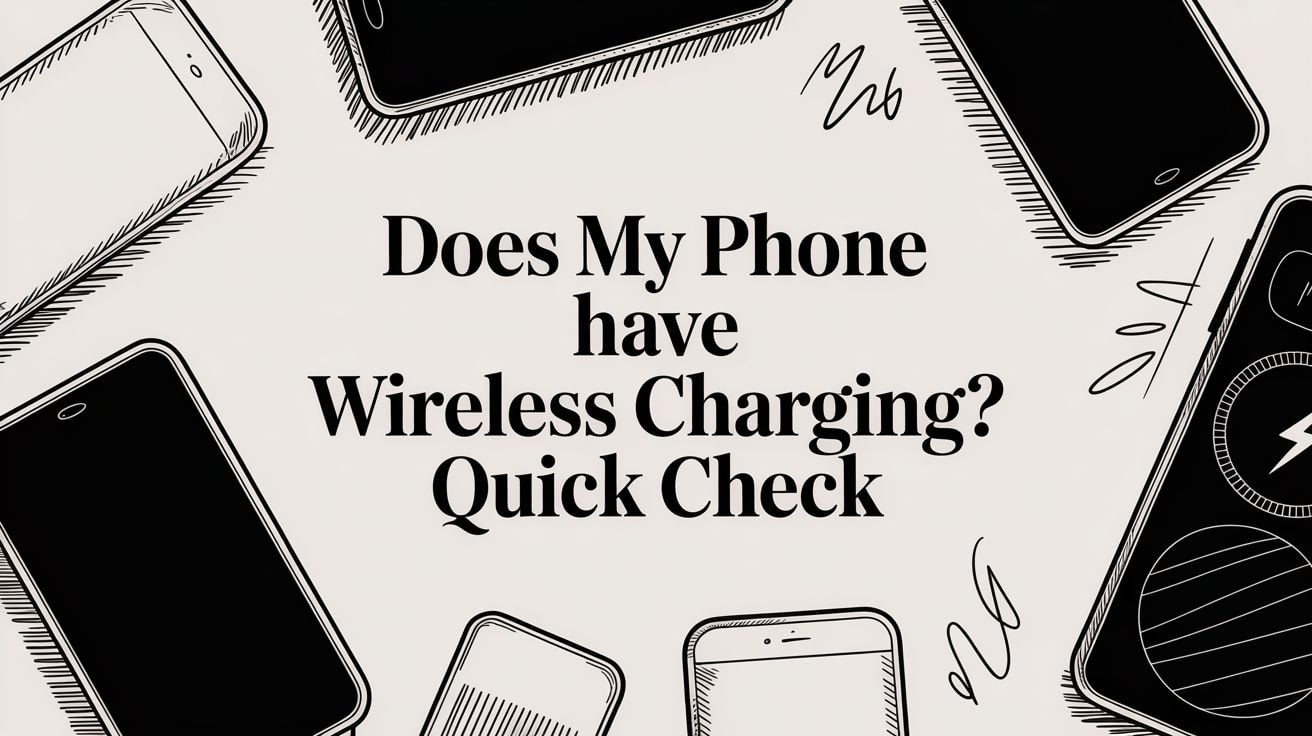
Does My Phone Have Wireless Charging? Quick Check
Trying to figure out if your phone supports wireless charging can feel like a bit of a scavenger hunt, but it's usually simpler than you think. Most newer top-of-the-line phones from Apple, Samsung, and Google have this built right in. But if you're not sure, the quickest way to confirm is to check the phone's original box for the "Qi" logo.
Your Guide to Wireless Charging Basics
So, what is wireless charging anyway? It’s a way to power up your phone without fumbling with a cable. Instead of plugging a wire into your phone’s tiny port, you just set it down on a special pad or stand, and it starts charging.
The magic behind this is a technology called Qi (you say it like "chee"). It's the universal standard that almost every phone maker has agreed on. Think of it like Wi-Fi for power—if your phone and the charger both have Qi, they’ll work together perfectly. It’s this cable-free life that has made wireless charging a must-have feature, saving your charging port from wear and tear and clearing up that mess of tangled wires on your nightstand.
The Fastest Ways to Check
Before you start digging through your phone's settings or searching online, a few quick visual checks can give you the answer in seconds. Honestly, these are the best first steps.
Fast Check Methods for Wireless Charging
Use these quick methods to see if your smartphone supports wireless charging without diving into settings.
| Method | What to Look For | Success Indicator |
|---|---|---|
| The Original Box | The official Qi logo or text like "Qi-certified" or "wireless charging." | This is your most reliable confirmation. |
| Phone's Back Panel | A glass or smooth plastic back. | Metal backs almost always block wireless charging. |
| Printed Symbols | A small lightning bolt or wireless symbol on the back. | Some older models used this to show where the charging spot is. |
These are the go-to methods I use myself before anything else. Checking the box is the best way, but a quick look at what the phone is made of is often a dead giveaway.
This handy little decision tree breaks down the process visually. It's the exact path I'd follow to get an answer fast.
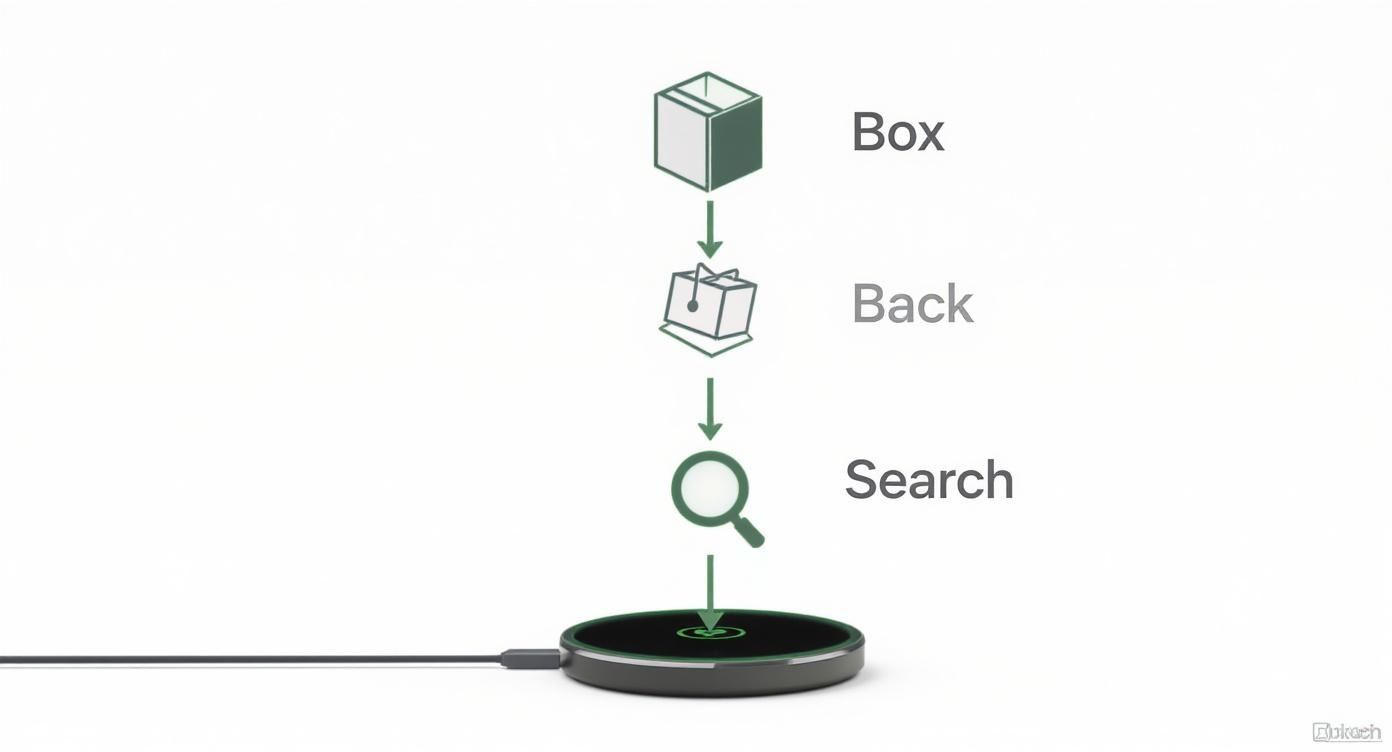
More often than not, the answer is right there on the packaging or the device itself. No need to get lost in a maze of settings menus.
Finding the Official Answer in Your Phone's Specs
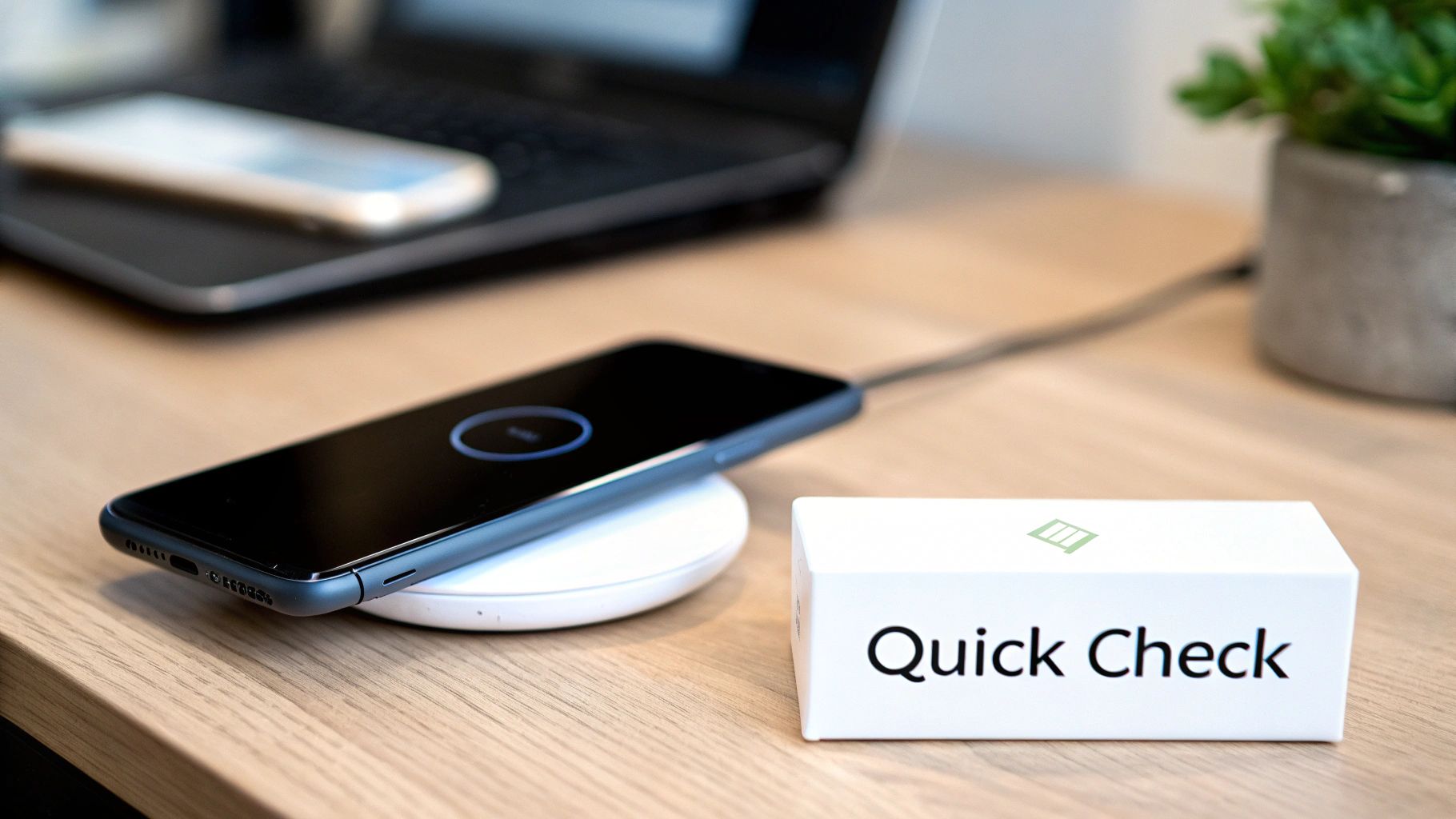
Dive into your Settings and scroll down to About Phone (or About Device). Right there you’ll find your device’s exact model name and number.
If you’ve ever paused to wonder “does my phone have wireless charging?”, grabbing that full model info is the fastest shortcut to the answer.
Locating The Model Name
Tap About Phone or About Device to see your model details. Note every letter and number exactly as shown.
- Galaxy S23 Ultra is a perfect example of how the model might appear.
- Tap and hold on the model name to copy it directly.
- Double-check spelling and capitalization to avoid typos.
This simple action takes just seconds but prevents wasted time later.
Manufacturer websites and trusted tech sites always list features like Qi-compatible charging in their spec tables.
Next, open your mobile browser and paste or type in your model name along with charging keywords.
- Search for “[Your Model] wireless charging”
- If results seem vague, add specs or features to your search.
- Give priority to official websites or respected tech reviews.
Once the spec sheet appears, look for key phrases like wireless charging or Qi. If it’s listed, you’ve got your confirmation.
Spotting Reliable Sources
Avoid random forum posts or sketchy blogs. Instead, stick with well-known sites:
- Official brand websites (e.g., Apple, Samsung)
- Leading tech sites such as TechRadar or CNET
- Support pages from your phone’s maker
If in doubt, check at least two sources. If they say the same thing, you've found your answer.
This approach cuts through the noise when you’re hunting for wireless charging support. Within minutes, you’ll have a clear yes or no based on solid facts.
Tip: Bookmark the official spec page for future quick checks.
Physical Clues That Hint at Wireless Charging Support
Sometimes, you can figure out if your phone can charge wirelessly just by holding it. The way a phone is built—its materials and design—often tells you a lot about what's going on inside, and this is definitely true for charging tech.
The biggest giveaway is the back of your phone. Is it made of glass or a smooth, non-metallic plastic? If it is, there’s a solid chance it has wireless charging built-in. That's because the technology uses a special energy field that metal just can't get through. You can learn more in articles that explain the evolution of battery and charging technologies.
What to Look For on the Back Panel
Think about a top-tier phone like a recent Samsung Galaxy or an iPhone. They almost always have a slick glass back. On the other hand, many budget-friendly phones are built with aluminum or a textured plastic case, which is a pretty clear sign that wireless charging was left off the feature list.
Here's a common misconception I see all the time: people think that if their phone has a modern USB-C port, it must support wireless charging. That’s simply not true. The type of charging port has nothing to do with the special part inside the phone needed to receive power wirelessly.
What to Ignore
Don’t get sidetracked by other fancy features. It’s easy to assume that a phone with a great camera or a super-fast processor would also have wireless charging, but those things aren't directly related.
At the end of the day, the most reliable physical clue is the material on the back of the phone. If you're looking at a device with a metal body, it’s almost certain it won’t support wireless charging without a special case or adapter. This one simple check can save you a lot of time before you even bother looking up the official specs online.
Why Wireless Charging Is Becoming a Standard Feature
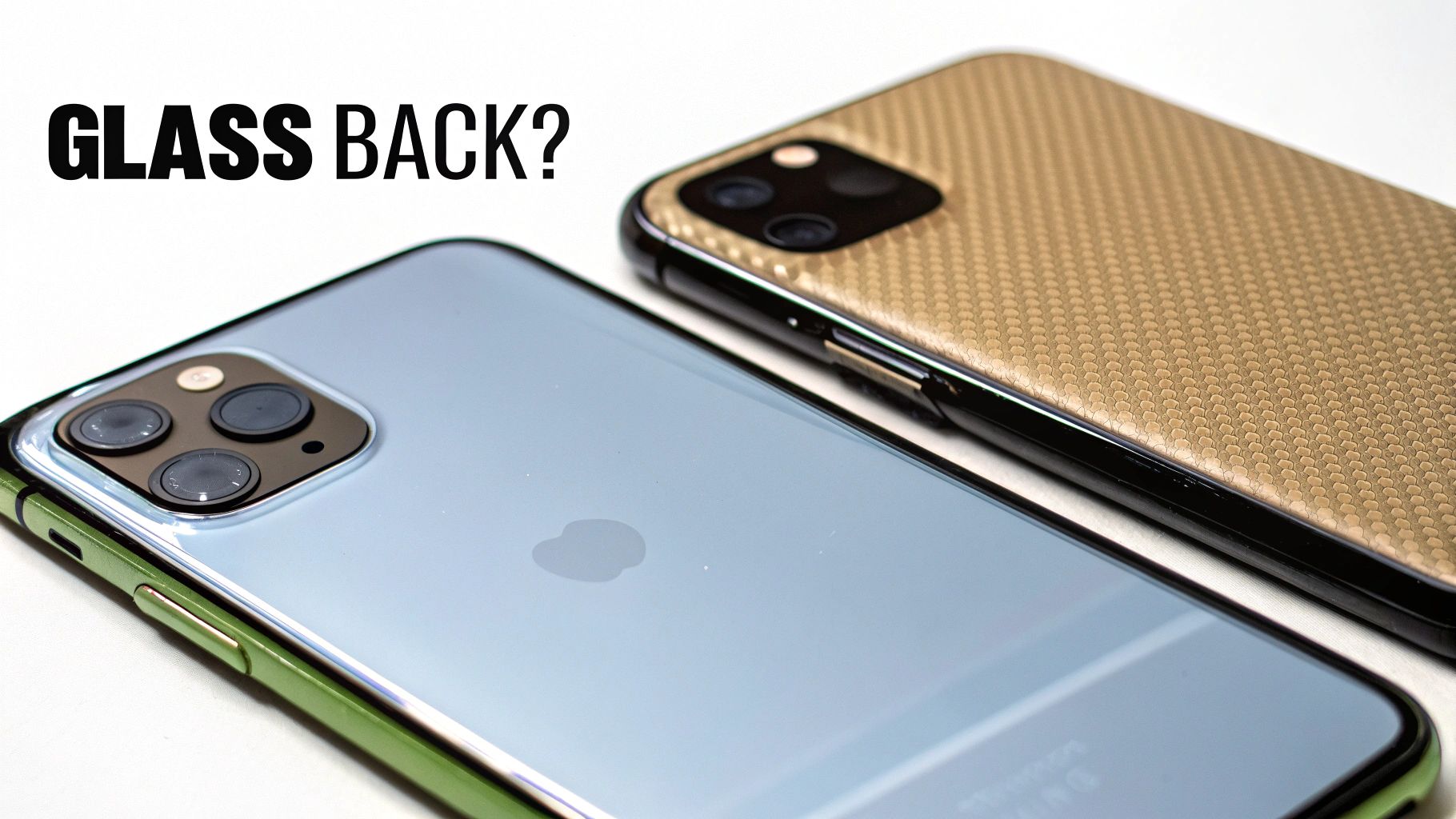
Ever wonder why those little charging pads seem to be popping up everywhere? The simple answer is convenience. We all want a life with fewer tangled cables, and phone manufacturers have definitely been listening. Wireless charging is no longer a luxury add-on; it's becoming a core feature.
A huge part of this shift is thanks to a single, universal standard called Qi (pronounced "chee"). This agreement ensures that a phone from one company can power up on a charging pad from a completely different one. This universal handshake has made it incredibly easy for everyone to build the tech into their devices without creating a compatibility nightmare.
From a Novelty to a Necessity
The technology has officially moved beyond our nightstands and desks. You can now find Qi charging pads built right into new cars, hotel lamps, and even the tables at your local coffee shop. This growing availability makes the feature more practical than ever, making it an expected part of the modern smartphone experience.
The numbers back this up. As of late 2023, nearly 70% of all smartphones shipped worldwide came with wireless charging built-in—a massive jump from just a few years ago. This growth is almost entirely fueled by customer demand and the widespread acceptance of the Qi standard across thousands of products.
The real change happened when users stopped seeing wireless charging as a cool trick and started seeing it as a practical tool for daily life. When your car, office, and home all support it, the convenience becomes undeniable.
The Broader Tech Evolution
This move toward a cable-free world is part of a much larger trend. The way we get power to our devices has changed a lot over the years.
Ultimately, the sheer ease of dropping your phone on a pad is hard to beat, making it a feature people now actively look for. This growing demand is exactly why the answer to "does my phone have wireless charging?" is, more and more often, a simple "yes." And there are many great articles online about the growing smartphone wireless charging market.
How the Big Phone Brands Handle Wireless Charging
Sometimes, the quickest way to figure out if your phone has wireless charging is just by knowing its brand. Phone makers often reserve fancy features for their premium models to keep the costs of their budget-friendly phones down.
Take Apple, for instance. Their approach is refreshingly simple. If you've got an iPhone made since the iPhone 8 back in 2017, you're golden. Every single model since then has wireless charging built right in. No guesswork needed.
Samsung has been in the wireless charging game for a long time, too. Their top-tier Galaxy S and Galaxy Note/Ultra series have had this feature for years. So, if you're holding one of Samsung's flagship phones, it's a safe bet you can drop it on a charging pad.
The Flagship vs. Budget Divide
Google follows a similar playbook with its Pixel phones. The high-end "Pro" models? They've consistently got wireless charging. The more affordable "a-series," on the other hand, usually sticks to a cable. It's a common strategy—brands use features like this to draw a clear line between their best phones and their mid-range or budget options.
Here's a solid rule of thumb: a phone's price tag is one of the best clues. You expect a high-end device to have all the bells and whistles, including wireless charging. Budget phones are built to cover the basics without the extra frills.
Even though wireless charging is becoming more common, there's still a big gap. While it's pretty much standard on flagship phones, as of 2024, less than 30% of smartphones under $300 had the feature. You see this a lot in markets where low-cost phones are the big sellers.
That said, the technology is becoming more popular globally, and it's on track to become a massive industry. You can dig into the data on the surge in consumer interest in wireless power to see where things are headed.
Knowing these brand tendencies can save you a lot of time. If you own a top phone from Apple, Samsung, or Google, chances are you're all set. If it’s a budget model, you’ll likely need to keep that charging cable handy.
So, you've discovered your phone doesn't have wireless charging built-in. It's a bit of a bummer, especially if you were looking forward to a cable-free life. But don't worry. There’s a surprisingly simple and cheap way to give almost any modern phone that same convenience.
The magic trick is something called a wireless charging adapter.
It's basically a super-thin receiver that plugs right into your phone's charging port—whether that's a USB-C or a Lightning port for an iPhone. It then sticks flat against the back of your device, ready to go.
How These Little Adapters Work
Picture a small, flat pad with a short, flexible cable attached. Inside that pad is the special part that catches the wireless power. You just plug the tiny cable into your phone’s charging port, fold the pad onto the back, and secure it.
Honestly, most of them are so slim they completely disappear once you snap your phone case back on. I've used them on older phones and you'd never even know it's there.
With that little adapter installed, your phone is now ready for any standard Qi wireless charging pad. You can just set it down to power up, exactly like a phone that came with the feature from the factory. It’s a clean, effective upgrade that solves the problem.
The real beauty of this is its simplicity. You don't need any technical skills, and it doesn't permanently change your phone. It's a true plug-and-play solution that brings modern convenience to a device that missed out.
Picking the Right Adapter for Your Phone
When you're ready to buy one, there's really only one critical thing to get right: matching it to your phone’s charging port. It's an easy mistake to make, so pay close attention.
- For iPhones: You’ll need an adapter with a Lightning connector.
- For most Android phones: Grab one with a USB-C connector.
- For older Androids: You might still need a Micro-USB adapter.
Just double-check your phone's port before you click "buy." It's a simple step that turns the question from "does my phone have wireless charging?" into "how can I add it?"
And for anyone thinking about long-term battery health, you can even pair these adapters with tools that manage your charging. To see how that works, you can learn more about how Chargie enhances both wired and wireless chargers to keep your battery in top shape.
Your Burning Questions About Wireless Charging
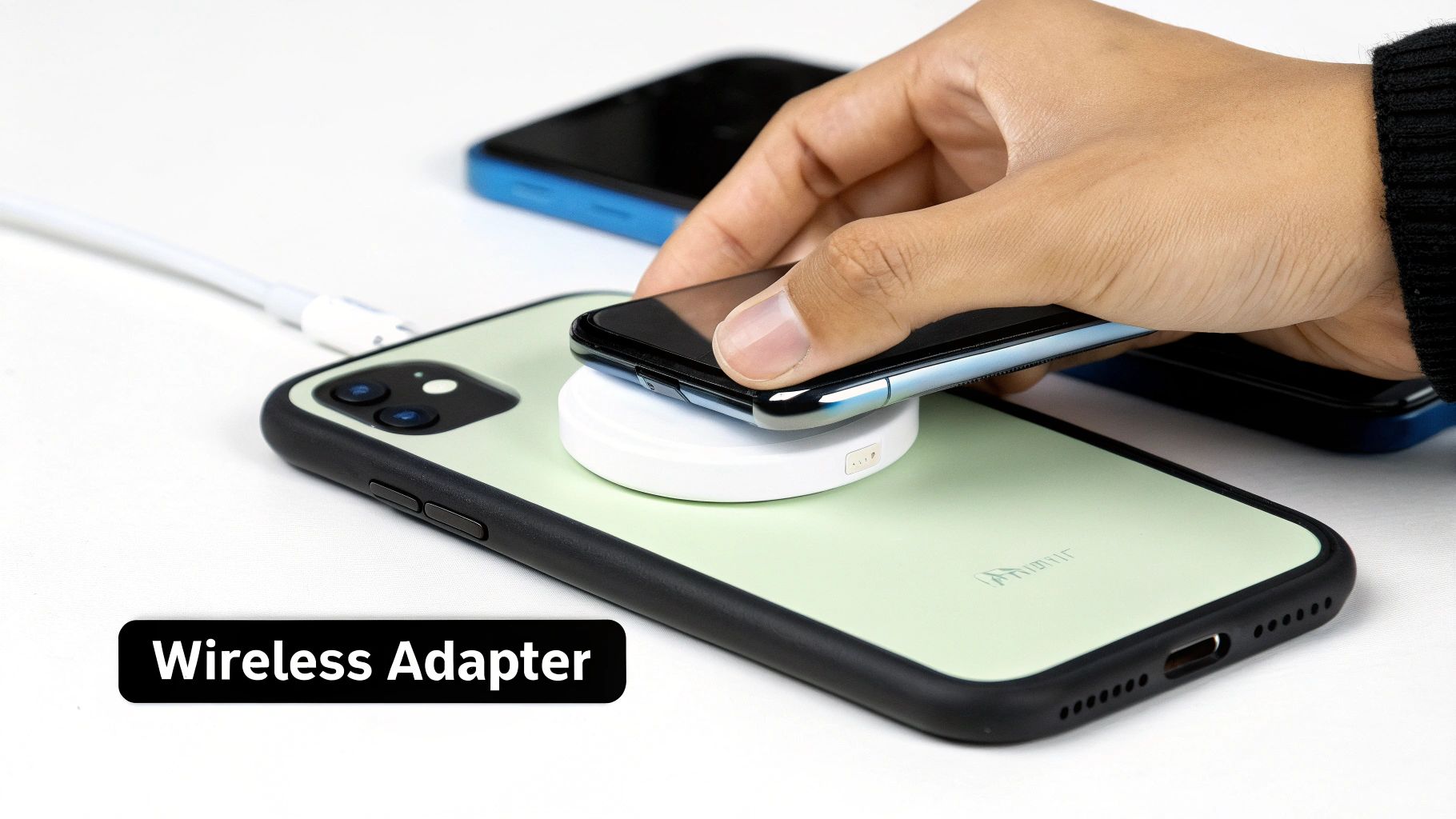
Okay, so you've confirmed your phone is ready for a cable-free life. Now what? A few practical questions always seem to pop up as people make the switch. Let's get them answered so you can start charging with confidence.
One of the first things people ask is, "Is it actually slower than just plugging it in?" The short answer is, usually, yes. While high-speed wireless chargers are getting impressively quick, a good old-fashioned fast-charging cable is almost always going to win the race. Wireless charging is all about trading a little bit of speed for a whole lot of convenience.
Then comes the phone case question. Can you actually use a wireless charger with your case on? For the most part, you absolutely can. Most standard plastic, silicone, or leather cases under 3mm thick won't cause any issues. The problems start when you have a super-thick, rugged case or one with metal plates or a pop socket on the back—those will definitely block the connection.
Other Practical Concerns
What about leaving your phone on the pad all night? That's a big one. People worry about overcharging and ruining their battery. The good news is that modern smartphones are smart. They automatically stop drawing power once the battery hits 100%, so you don't need to stress about it. The charger and your phone work together to prevent any damage.
Finally, do all chargers work with all phones? This is where the universal Qi standard (pronounced "chee") comes in. If your phone and charger are both Qi-certified, they’ll play nicely together, no matter the brand. It's a lifesaver.
The convenience of at-home wireless charging has clearly connected with users. It simplifies daily routines by turning any surface into a power source, which is why more and more people are using it.
This isn't just a feeling; the numbers back it up. A survey from the Wireless Power Consortium found that over 60% of people with capable smartphones were already using wireless charging regularly at home. The global market, now valued at over $6 billion, shows this feature is quickly moving from a "nice-to-have" to a standard expectation.

